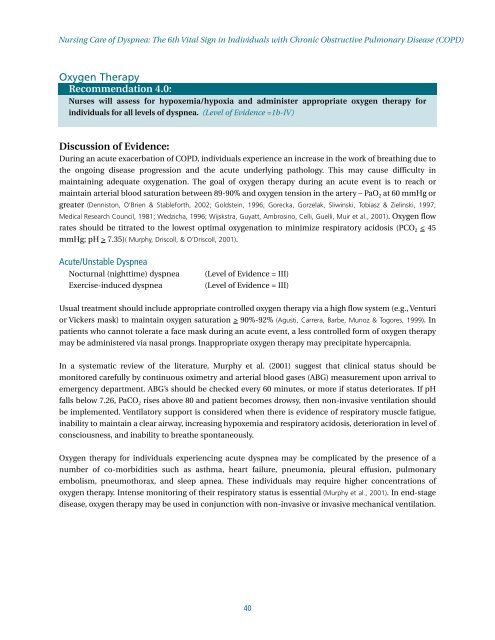Nursing Care of Dyspnea: The 6th Vital Sign in Individuals with ...
Nursing Care of Dyspnea: The 6th Vital Sign in Individuals with ...
Nursing Care of Dyspnea: The 6th Vital Sign in Individuals with ...
Create successful ePaper yourself
Turn your PDF publications into a flip-book with our unique Google optimized e-Paper software.
<strong>Nurs<strong>in</strong>g</strong> <strong>Care</strong> <strong>of</strong> <strong>Dyspnea</strong>: <strong>The</strong> <strong>6th</strong> <strong>Vital</strong> <strong>Sign</strong> <strong>in</strong> <strong>Individuals</strong> <strong>with</strong> Chronic Obstructive Pulmonary Disease (COPD)Oxygen <strong>The</strong>rapyRecommendation 4.0:Nurses will assess for hypoxemia/hypoxia and adm<strong>in</strong>ister appropriate oxygen therapy for<strong>in</strong>dividuals for all levels <strong>of</strong> dyspnea. (Level <strong>of</strong> Evidence =1b-IV)Discussion <strong>of</strong> Evidence:Dur<strong>in</strong>g an acute exacerbation <strong>of</strong> COPD, <strong>in</strong>dividuals experience an <strong>in</strong>crease <strong>in</strong> the work <strong>of</strong> breath<strong>in</strong>g due tothe ongo<strong>in</strong>g disease progression and the acute underly<strong>in</strong>g pathology. This may cause difficulty <strong>in</strong>ma<strong>in</strong>ta<strong>in</strong><strong>in</strong>g adequate oxygenation. <strong>The</strong> goal <strong>of</strong> oxygen therapy dur<strong>in</strong>g an acute event is to reach orma<strong>in</strong>ta<strong>in</strong> arterial blood saturation between 89-90% and oxygen tension <strong>in</strong> the artery – PaO 2 at 60 mmHg orgreater (Denniston, O’Brien & Stableforth, 2002; Goldste<strong>in</strong>, 1996; Gorecka, Gorzelak, Sliw<strong>in</strong>ski, Tobiasz & Ziel<strong>in</strong>ski, 1997;Medical Research Council, 1981; Wedzicha, 1996; Wijskstra, Guyatt, Ambros<strong>in</strong>o, Celli, Guelli, Muir et al., 2001). Oxygen flowrates should be titrated to the lowest optimal oxygenation to m<strong>in</strong>imize respiratory acidosis (PCO 2 < 45mmHg; pH > 7.35)( Murphy, Driscoll, & O’Driscoll, 2001).Acute/Unstable <strong>Dyspnea</strong>Nocturnal (nighttime) dyspneaExercise-<strong>in</strong>duced dyspnea(Level <strong>of</strong> Evidence = III)(Level <strong>of</strong> Evidence = III)Usual treatment should <strong>in</strong>clude appropriate controlled oxygen therapy via a high flow system (e.g., Venturior Vickers mask) to ma<strong>in</strong>ta<strong>in</strong> oxygen saturation > 90%-92% (Agusti, Carrera, Barbe, Munoz & Togores, 1999). Inpatients who cannot tolerate a face mask dur<strong>in</strong>g an acute event, a less controlled form <strong>of</strong> oxygen therapymay be adm<strong>in</strong>istered via nasal prongs. Inappropriate oxygen therapy may precipitate hypercapnia.In a systematic review <strong>of</strong> the literature, Murphy et al. (2001) suggest that cl<strong>in</strong>ical status should bemonitored carefully by cont<strong>in</strong>uous oximetry and arterial blood gases (ABG) measurement upon arrival toemergency department. ABG’s should be checked every 60 m<strong>in</strong>utes, or more if status deteriorates. If pHfalls below 7.26, PaCO 2 rises above 80 and patient becomes drowsy, then non-<strong>in</strong>vasive ventilation shouldbe implemented. Ventilatory support is considered when there is evidence <strong>of</strong> respiratory muscle fatigue,<strong>in</strong>ability to ma<strong>in</strong>ta<strong>in</strong> a clear airway, <strong>in</strong>creas<strong>in</strong>g hypoxemia and respiratory acidosis, deterioration <strong>in</strong> level <strong>of</strong>consciousness, and <strong>in</strong>ability to breathe spontaneously.Oxygen therapy for <strong>in</strong>dividuals experienc<strong>in</strong>g acute dyspnea may be complicated by the presence <strong>of</strong> anumber <strong>of</strong> co-morbidities such as asthma, heart failure, pneumonia, pleural effusion, pulmonaryembolism, pneumothorax, and sleep apnea. <strong>The</strong>se <strong>in</strong>dividuals may require higher concentrations <strong>of</strong>oxygen therapy. Intense monitor<strong>in</strong>g <strong>of</strong> their respiratory status is essential (Murphy et al., 2001). In end-stagedisease, oxygen therapy may be used <strong>in</strong> conjunction <strong>with</strong> non-<strong>in</strong>vasive or <strong>in</strong>vasive mechanical ventilation.40
















